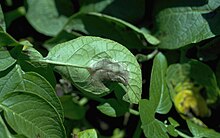Potato blight
Potato blight is a type of fungal disease. One well known example of potato blight was the disease which caused the Irish potato famine of 1845 to 1852, and the 1846 Highland potato famines.
| Potato blight | |
|---|---|

| |
| Symptom of late blight on the underside of a potato leaf | |
| Scientific classification | |
| Domain: | Eukaryota |
| Clade: | Diaphoretickes |
| Clade: | SAR |
| Phylum: | Oomycota |
| Order: | Peronosporales |
| Family: | Peronosporaceae |
| Genus: | Phytophthora |
| Species: | P. infestans
|
| Binomial name | |
| Phytophthora infestans | |
The disease caused lots of famine. It was caused by an oomycete Phytophthora infestans. The oomycetes or water moulds are similar to fungi, but they are in a different Kingdom.
Overview
changePhytophthora infestans in Ireland caused over one million to starve to death and another two million people to move from affected countries.[1] During the 1840s the blight damaged crops in Scotland and Europe also. It was the only important cash crop in Ireland, which explains its greater effect there. Also, most of the Irish crop was one variety, the Irish Lumper.
The first recorded instances of the disease were in the United States, in Philadelphia and New York City in early 1843. It crossed the Atlantic Ocean with a shipment of seed potatoes for Belgian farmers in 1845.[2] All of the potato-growing countries in Europe were affected, but the potato blight hit Ireland the hardest. The lack of genetic variability created a susceptible host population for the organism.[3]
Genetic engineering
changeGenetic engineering for resistant cultivars is developing. A resistance gene effective against most known strains of blight has been found in a wild relative of the potato. It is introduced by genetic engineering into cultivated varieties of potato.[4][5]
References
change- ↑ Ross, David 2002. Ireland: history of a nation. New Lanark: Geddes & Grosset. ISBN 1-84205-164-4
- ↑ Reader, John (March 17, 2008), "The fungus that conquered Europe", New York Times, retrieved 2008-03-18
- ↑ "Great Famine potato makes a comeback after 170 years". IrishCentral. 3 March 2013. Retrieved 2013-03-05.
- ↑ Song, Junqi 2003. (2003), "Gene RB cloned from Solanum bulbocastanum confers broad spectrum resistance to potato late blight", Proceedings of the National Academy of Sciences, 100 (16): 9128–9133, doi:10.1073/pnas.1533501100, PMC 170883, PMID 12872003
{{citation}}: CS1 maint: numeric names: authors list (link) - ↑ Jacobsen E. & Schouten H.J. 2008. Cisgenesis, a new tool for traditional plant breeding, should be exempted from the regulation on genetically modified organisms in a step by step approach. Potato Research 51: 75–88. Free version Archived 2015-09-23 at the Wayback Machine